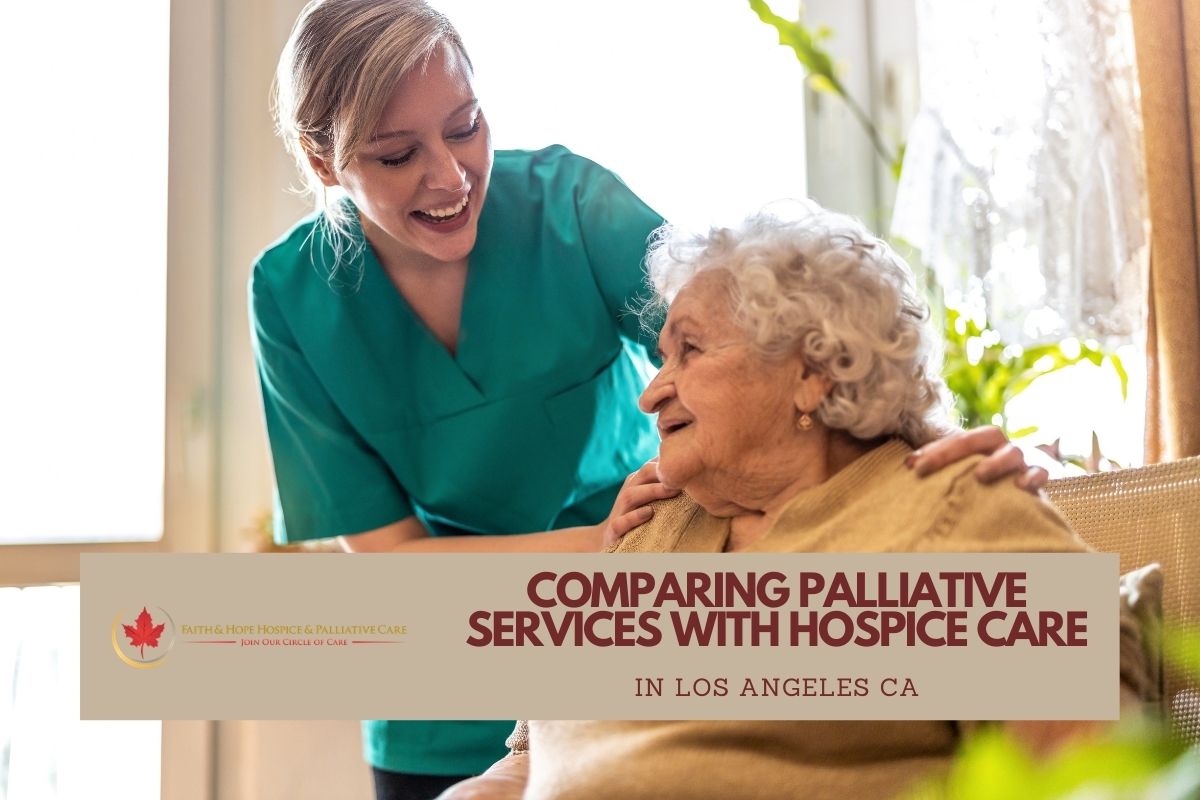
- By: administrator
- Blog
- No Comments
When faced with a life-threatening illness, patients may be offered one of two care services: hospice care and palliative care. Both aim to provide physical, emotional, and spiritual support to a suffering individual. However, they are not the same thing. Hospice experts in Los Angeles CA delve into the similarities and differences that make up both avenues of care and why some agencies can offer both services.
Hospice care is defined as a health service that prioritizes the comfort and quality of life of a patient that is terminally ill. Patients are eligible for hospice care when they are given a prognosis of six months or less and are no longer receiving curative treatments. Ultimately, hospice care prepares a patient for a peaceful death by relieving pain and providing the resources for fulfillment in their last days.
Palliative care is another form of care that seeks to alleviate physical and emotional suffering for those facing illness. It may involve the prevention and treatment of side effects and symptoms. The primary goals are pain and symptom management. While not curative in itself, palliative care can be pursued by patients at all stages of their disease, from diagnosis to treatment to end of life.
Both palliative and hospice care in Los Angeles require teams that can address the specific physical, emotional, and spiritual suffering of a patient by evaluating their wellbeing and communicating with their primary care physicians. They specialize in pain management and offer resources such as music therapy and other holistic forms of treatment. They also provide moral support to the family, friends, and other individuals that are close to the patient. By lowering the stress levels of the patient and their loved ones, hospice and palliative services transform a dark period in an individual’s life into something ripe with meaning and fulfillment.
If you compare palliative and hospice services in Los Angeles CA, you will see that the objective is similar: to relieve pain and other uncomfortable symptoms in a patient suffering from a life-limiting illness. However, the care tends to vary between both services. Patients enrolled in hospice care forgo curative efforts because they no longer have any options or because their treatment options would only lower their quality of life. On the other hand, patients enrolled in palliative care may be receiving curative treatment at the same time. This service is typically chosen for patients undergoing chemotherapy or other difficult treatments.
Hospice care is fully covered by Medicaid, Medicare, and most private insurances. Under Medicare, hospice coverage includes nursing, nursing aides, social worker, and, chaplain visits, as well as grief support, equipment, and medications. Palliative care coverage depends on the patient’s individual insurance plan and the provider. While Medicaid and Medicare Part B may cover certain services, the patient will likely be responsible for co-pays.
Another difference between palliative care and hospice care is the level of access. Patients may become eligible for hospice care only if their diagnosis meets certain qualifications. Typically, when a patient is given six months to live (or less). Once a patient’s illness is certified as terminal, that patient may be enrolled in hospice care. Palliative care is much more open to patients undergoing various stages of illness. For example, a patient may enter into palliative care whether or not they know if their illness is terminal.
Both hospice and palliative care can be provided at a patient’s place of residence, whether that be a house, apartment, assisted living facility, nursing home, or veterans’ facility. Hospice and palliative care teams put in place pain management systems and train a patient’s loved ones or caretaker to administer day-to-day care. Caretakers and family members may also be offered services for grief counseling and other emotional support during this trying time.
When a loved one is suffering, it can be difficult to know what to do. Hospice or palliative care could be the solution. The best way to choose between these two options is to consult the patient’s primary care physician. Generally, if a patient does not qualify for hospice, then palliative care is the next best thing. Whether a patient is facing dementia, Parkinson’s disease, heart failure, chronic obstructive pulmonary disease, or cancer, they may enroll in palliative care at any stage. This service can help them manage their symptoms, understand their options when it comes to treatment, and achieve the quality of life they deserve.
The main differences between hospice and palliative services are that hospice care requires a six-month prognosis and, in practice, discontinues any curative treatments. In addition to this, hospice is more universally covered by insurance. Otherwise, both services require smart and caring individuals to alleviate a patient’s pain and support their loved ones. Hospice or palliative care experts are trained in caring for both verbal and non-verbal patients and work with caretakers or family members to elevate their daily level of care. Patients may require any combination of treatments, from medications to therapy sessions. Essentially, both services are focused on maintaining a high quality of life for the patient. That is why many care facilities offer both services to eligible patients.
If you or your loved one is struggling with a life-limiting illness, then contact Faith & Hope Hospice and Palliative at (866) 441-5070 to learn more about hospice and palliative services. Our home-based care caters to individuals living in retirement communities, assisted living facilities, convalescent hospitals, skilled nursing facilities, apartments, homes, and any other residency. We are a trusted member of the National Hospice and Palliative Care Organization and are accredited by The Joint Commission. Visit our website to request a free consultation: https://faithandhopehospice.com/

